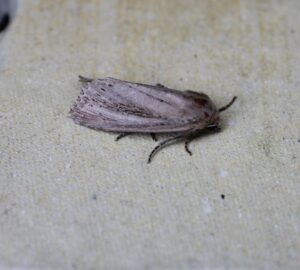9 September 2021
9 September 2021 – Reed Mace and Wainscots
Bulrush Wainscot (Nonagria typhae)
A surprise in the trap this morning, a very welcome surprise. The dominant species flying that night was immediately apparent – Setaceous Hebrew Characters (Xestia c-negrum) were clinging to every surface with dozens of crane flies for company. A Canary-shouldered Thorn (Ennomos alniaria) and a few Brimstone Moths (Oposthograptis lutolata) added a splash of colour but it was a rather sluggish looking moth, different from any other I had seen, that was puzzling. Was it a Large Wainscot? I had only seen that moth (Rhizedra lutosa) once before but I didn’t remember seeing so many black dots on the trailing edges of the forewings, all sweeping down to create two rather mysterious v-shapes.
I went to look at the Field Guide and looked at Richard Lewington drawings but it still wasn’t certain as to which Wainscot it could be…
 |
| Bulrush Moth (1) and Large Wainscot (4) |
British Moths and their Transformations (Humphreys and Westwood) provided me with an image of what seemed to be a beautiful ballet of Wainscot moths but, at the time, one was known by the name of the caterpillar’s food plant only – the bulrush. A click on the image will enlarge the differences between the Bulrush Moth (Fig 1) and the Large Wainscot (Fig 4).
At this point I contacted Charlie Fletcher who confirmed that the photograph (above) I had sent him was Nonagria typhae and that was a new species for the garden.
Recent Moths
- 25 July 2023 – Collective Noun for Hawkmoths
- MOTH LIST to August 2023 with links
- 28 July 2023 – TRIPLE New Species Alert!
- 18 July 2023 – A Golden…Plusia!
- 13 July 2023 – Arts and Sciences
- 10 July 2023 – Rise of the Yellow Underwings
- 4 July 2023 – Cold-weather Catch
- 4 July 2023 – Mother of Pearl, an Inspiration to Science
- 28 June 2023 – Buff-tipped Marble
- 23 June 2023 – Moth or Butterfly?
- 20 June 2023 – Bee, Straw, Emerald and a Ghost
- 17 June 2023 – Old and New







